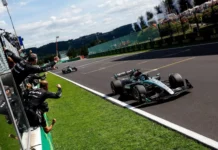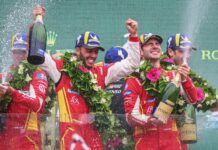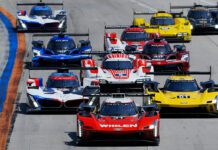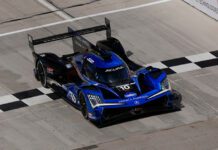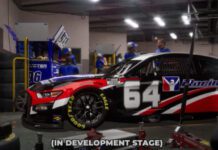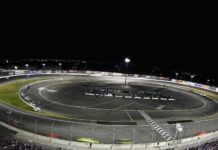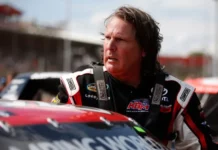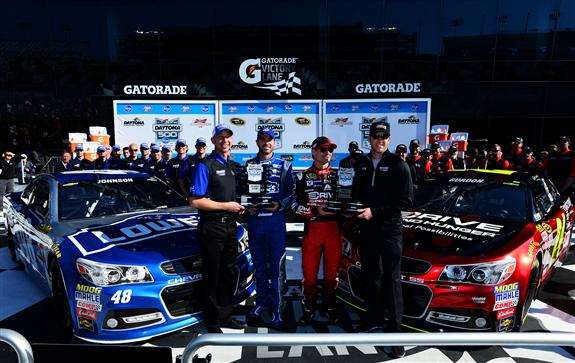Jeff Gordon won a high-stakes game of “Beat the Clock” on Sunday, with the pole for his final Daytona 500 the ultimate prize.
Gordon crossed the start/finish line to start his pole-winning lap as time expired in the final round of knockout qualifying at Daytona International Speedway.
His time of 44.711 seconds was .035 seconds better than that of Hendrick Motorsports teammate Jimmie Johnson, who secured the outside front-row starting spot for next Sunday’s 57th running of the Great American Race (1 p.m. ET on FOX). His lap of 201.293 mph was the fifth-fastest Daytona 500 pole speed ever and fastest since Bill Elliott’s record-setting lap in 1987 at 210.364 mph.
The first use of group knockout qualifying at Daytona, under a format introduced last fall at Talladega, determined only the two front-row starting positions for the 500. However, the next four fastest drivers — with speeds counted from any of the three qualifying rounds — also locked themselves into the field, with specific starting positions to be determined after Thursday night’s Budweiser Duel at Daytona (7 p.m. ET on FOX Sports 1).
Those drivers were Aric Almirola, whose 202.340 mph speed in the first round was the fastest of any session; Ricky Stenhouse Jr., Carl Edwards and Jamie McMurray.
The pole was Gordon’s fourth at Daytona and the 78th of his career. Gordon has announced his retirement from full-time competition at the end of the season and has said this year’s Daytona 500 will be his last.
The front-row sweep was the fourth for Hendrick Motorsports.
 “This is definitely huge for many reasons,” Gordon said. “It’s one I’ve been stressing about for a while. This format is crazy and chaotic, and it can be extremely rewarding when you have a day like we had … and to be able to bring that kind of group effort together.
“This is definitely huge for many reasons,” Gordon said. “It’s one I’ve been stressing about for a while. This format is crazy and chaotic, and it can be extremely rewarding when you have a day like we had … and to be able to bring that kind of group effort together.
“In the past, this has been one of the easiest days I’ve had all year long. Just go out there and hold it wide open and run a couple of laps. It’s all about the team and the car and the preparation they put into it. All that hard work still goes into this effort, but I play a bigger role, the spotter plays a bigger role, and there’s just so much more strategy, trying to play this chess match and the time game and the wait game. It’s really intense.”
With less than two minutes left in the first five-minute qualifying session, Reed Sorenson’s ill-fated attempt to block Clint Bowyer into Turn 1 sparked a five-car wreck that took out Bowyer’s No. 15 Michael Waltrip Racing Toyota.
Also damaged in the crash was the No. 11 Toyota of Denny Hamlin, who was fastest (199.840 mph) in the first session among drivers who drew odd-number qualifying positions. But after cars with even-numbered positions ran incident free in the second session of the first round, Hamlin was relegated to 11th, and Aric Almirola topped the speed chart at 202.370 mph.
None of the four Stewart-Haas Racing Chevrolets, all of which were in the odd-number session of Round One, made the top 24 required to advance to the second round. But no driver was more incensed than Bowyer with the new qualifying system for the Daytona 500.
 “We used to come down here and worry about who would sit on the pole in the biggest race of the year,” Bowyer said. “Now all we do is come down here and worry about how a start-and-park (Sorenson) like this out of desperation is going to knock us out of the Daytona 500.”
“We used to come down here and worry about who would sit on the pole in the biggest race of the year,” Bowyer said. “Now all we do is come down here and worry about how a start-and-park (Sorenson) like this out of desperation is going to knock us out of the Daytona 500.”
Bowyer may have been the most strident opponent of the new system, but he wasn’t the only one. NASCAR Executive Vice President of Racing Operations Steve O’Donnell said the sanctioning body is open to discussions on how to improve the process.
“If you look at group qualifying as a whole, we felt it worked really well, but certainly there are some challenges on superspeedways,” O’Donnell said. “One of the reasons we moved away from single-car qualifying is — and I think you’ve heard that from the drivers as well — a lot of things go into it, aero packages, oils, different setups, based on one lap not really based on a race setup.
“You also heard Jeff Gordon and others also talk about putting it back in the drivers’ hands a little bit more. Those are things that we liked. I would say we certainly don’t want to see wrecks of any kind. It’s not lost on us how much work goes into these cars … for the biggest race of the year.”
For his part, Sorenson took responsibility for the wreck and apologized.
“As you can see, I was just trying to block,” Sorenson said. “That’s what got Matt Kenseth the win (Saturday) night (in the Sprint Unlimited). I was doing everything I could to stay in front of Clint. Pretty obvious what I was trying to do. I didn’t mean to wreck anybody or anything like that.
“Just a product of this qualifying, trying to get that one lap. I didn’t want it to end that way, that’s for sure. I apologize to all the guys. Try to get a car here and try to get in the race on Thursday.”
The wreck left Sorenson scrambling, given that his Xtreme Motorsports team came to Daytona without a backup car.
Johnson led the second round with a lap at 201.925 mph, followed by Hamlin, McMurray and Gordon. All four Hendrick Motorsports Chevrolets advanced to the final round, as did all four Joe Gibbs Racing Toyotas.
The No. 88 car of Dale Earnhardt Jr. failed post-qualifying inspection because it did not meet minimum height. It was too low on the left-front, all times were disallowed, and he will start 25th in first duel.
The No. 11 car of Hamlin also failed post-qualifying inspection because the split on the track bar was 3 3/4 inches when regulation is 3.0 inches maximum. He will start 24th in second duel.







